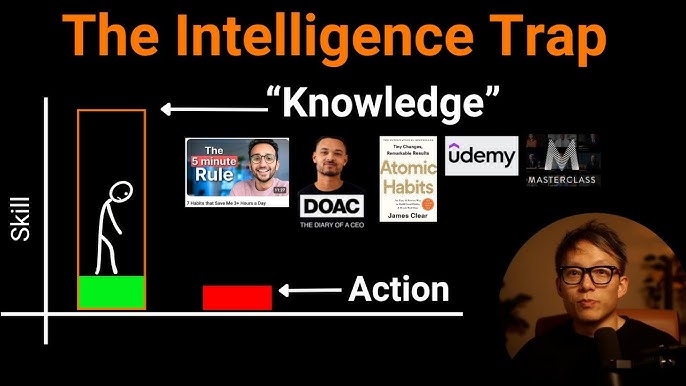
The 401(k) Myth That’s About to Cost You Big
Minority Mindset
20,261 views • 11 hours ago
Video Summary
Many Americans are not confident about retiring comfortably, with a significant gap between their retirement goals and current savings. The average 401k balances, particularly the median balances for those nearing retirement age, fall far short of the $1.6 million goal many workers envision. This shortfall is exacerbated by 401k fees and inflation, leading to a retirement crisis for millions. The video advocates for viewing the 401k not as the sole retirement vehicle but as one component within a broader wealth-building strategy that includes other assets like real estate and a diversified investment portfolio, emphasizing the importance of understanding investment vehicles and their limitations to accelerate wealth accumulation. A notable fact is that 99% of 401k offerings have cheaper, higher-performing alternatives available
Short Highlights
- 57% of 401k investors are not confident they can retire comfortably.
- The average 401k balance for those aged 55-64 is $272,000, with a median of $95,000.
- The traditional 4% rule suggests needing $1.5 million for a $60,000 annual retirement income.
- A 1% annual fee on a 401k can reduce total investment value by 25-28%.
- 99% of 401k offerings have cheaper, higher-performing fund alternativ
Key Details
The Retirement Savings Shortfall [0:00]
- A significant majority, 57%, of 401k investors lack confidence in their ability to retire comfortably.
- Workers anticipate retiring at age 66 and estimate needing $1.6 million saved.
- However, the average 401k balance for individuals aged 55-64 is only $272,000, and for those over 65, it's just under $300,000.
- The median balances are even more concerning: $95,000 for those aged 55-64 and also for those over 65.
- This substantial gap means millions of Americans' 401k savings will be insufficient for retirement.
"For millions of Americans, your 401k is not going to be enough."
Defining Retirement Goals and the 4% Rule [01:41]
- It's crucial to define retirement goals, encompassing both financial and non-financial aspects.
- Financially, the traditional "4% rule" is a common guideline to estimate retirement needs.
- This rule suggests calculating annual living expenses and dividing by 4% to determine the total retirement nest egg required.
- For example, a $60,000 annual need would require $1.5 million ($60,000 / 0.04).
- The 4% rule assumes withdrawals adjusted for inflation annually.
"The traditional rule here that pretty much every financial adviser will tell you is the 4% rule."
The Pitfalls of Early Retirement and Lack of Purpose [03:08]
- A common saying suggests "those who retire early die early."
- Many individuals who work jobs they dislike for decades may struggle with purpose and mental stimulation after retiring.
- Without a defined activity or passion, retired individuals might turn to passive entertainment, leading to a decline in mental and physical well-being.
- Planning for what one will do with their time and resources after achieving financial goals is as important as accumulating the wealth itself.
"So, I want you to start thinking about this because you might be seeing this with your parents. You might have seen it with your grandparents or your uncles or aunts or other people where when you get older and you hit that retirement number and now you just sit there doing nothing."
Traditional Retirement Vehicles: 401k and Home Equity [04:02]
- The two primary vehicles most people rely on for retirement are their 401k and their house.
- The assumption is that a paid-off house plus a 401k will suffice for retirement.
- However, this traditional path is failing for many, contributing to a major retirement crisis.
"And the way that you get there is through this vehicle. Now, a lot of people assume that the only vehicle to take you there is your 401k, but your 401k is one investment vehicle, and a lot of people are driving around in this Toyota Camry when you can turn it into a Lamborghini just by understanding how to use this vehicle better to get you to a bigger retirement or to get there even faster."
The Math Behind 401k Contributions and Returns [04:47]
- Consider a scenario with a $60,000 annual income and a 100% company match on 401k contributions up to 4% of salary.
- Investing 4% of $60,000 is $2,400 per year.
- With a 100% match, the total annual contribution becomes $4,800.
- Assuming consistent investment from age 25 to 65 (40 years) and an 8% annual return, the 401k could grow to $1.25 million.
- However, with a lower 5% annual return, the balance would only reach $580,000.
- Even the higher $1.25 million is still significantly short of the $1.5 million goal.
"So, that means you are investing effectively $4,800 a year. And this is what many people call free money. And you hope that this is going to help you get to that retirement number."
The Impact of Taxes on 401k Growth [06:22]
- A significant overlooked problem with traditional 401ks is taxation.
- Contributions to a traditional 401k are made pre-tax, and growth is tax-deferred.
- Taxes are paid upon withdrawal in retirement, reducing the net amount available.
- If Roth 401k contributions are made, taxes are paid upfront, resulting in a smaller contribution amount from the same gross income.
- For a traditional 401k yielding $1.25 million, after taxes are paid on withdrawal, the net amount will be even less than the $1.25 million, further widening the gap to retirement goals.
"This is taxed. Because if you put all of that money in, if you put all of your 4% of your income in, and that means that money was not taxed when it went in, the money grew tax-free. You have to pay taxes when the money comes out. This is how a traditional 401k works."
Mortgage Amortization and Equity Building [07:08]
- Monthly mortgage payments are often misunderstood regarding equity building.
- Banks use amortization schedules, which frontload interest payments.
- In the early years of a mortgage, a larger portion of the monthly payment goes towards interest, not principal.
- For a $300,000 loan at 6% interest, most of the $1,800 monthly payment covers interest.
- It takes approximately 19 years in a 30-year mortgage for half of the monthly payment to go towards principal.
"What actually happens is most of your $1,800 payment is going to interest for the first number of years on your mortgage."
Limitations of the Housing as a Wealth Vehicle [09:43]
- Owning a house has ongoing costs like property taxes and insurance, which increase with property value.
- A house valued at $1 million will incur significantly higher property taxes and insurance premiums, potentially making it unaffordable.
- Pulling money out requires a cash-out refinance, incurring new loan payments.
- Houses don't generate cash flow unless sold, and equity is often "invisible" until a sale occurs.
- Relying on housing equity for wealth building can be precarious, especially during economic downturns.
"The reason why I bring this up specifically is because let's say you buy a house in a good area. You buy it for $300,000 and now this house is worth a million dollar. Many people would say that you have hit the jackpot."
Constraints of the 401k [11:29]
- Limited Investment Options: Participants can only invest in funds approved by their company.
- Fees: Annual fees, even as low as 1%, can erode 25-28% of total investment returns over time. This is known as the expense ratio.
- Withdrawal Restrictions: Funds cannot be accessed without penalty until age 59 and a half, with early withdrawals incurring a penalty.
"Limitation number one with your 401k is you have limited options as to where you can invest."
The TRM Factors: Time, Return, and Money [12:58]
- Wealth accumulation is determined by three key factors: Time, Return, and Money.
- Time: The longer money compounds, the greater the wealth potential. This factor cannot be changed retrospectively.
- Return: Higher investment returns accelerate wealth growth.
- Money: The amount of money invested directly impacts the pace of wealth accumulation.
"Those three factors that will determine it are TRM, time, return, and money."
Strategies to Supercharge Investments [13:33]
- Analyze 401k Funds: Review fund performance and fees, as many companies offer high-cost, underperforming options. Researching alternatives can improve returns and reduce costs.
- Diversify Investment Vehicles: Invest in assets beyond the 401k, such as self-directed brokerage accounts for stocks and ETFs. Platforms like E*TRADE, Schwab, and M1 (for passive investing) are mentioned.
- Real Estate: Invest in rental properties to generate cash flow, which can cover expenses and provide profit. Strategic purchases, like multi-unit properties as a primary residence, can help pay off mortgages.
- Investment Risk Tolerance: Understand that investments vary in risk and potential return. Blue-chip stocks offer stability, while startups may offer higher growth but with greater risk.
"So, if we want to supercharge these vehicles to get you to that retirement number even faster, we have to understand the limitations here. That way you can find alternative options to supplement these to help you get to that retirement faster and easier."
Taking Control of Financial Future [18:33]
- Individuals must actively manage their finances, similar to how they manage their health.
- Blindly relying on a 401k is insufficient; proactive planning and understanding of financial vehicles are essential.
- Achieving financial goals requires making informed decisions about investments and savings.
"This is where it is so important for you as an investor to understand that it is in your hands."
The Importance of a Holistic Retirement Plan [19:13]
- Early planning is crucial for a secure retirement.
- Determine financial goals, identify appropriate investment vehicles, and consider the non-financial aspects of life post-retirement.
- Building multiple income streams and supercharging investment vehicles can lead to achieving financial freedom sooner, allowing for a more fulfilling life.
"If you don't want to be in that position, start planning early. Think about what you need to do to get to that number."
Other People Also See



